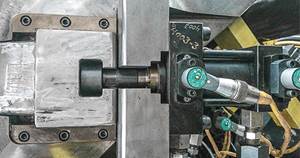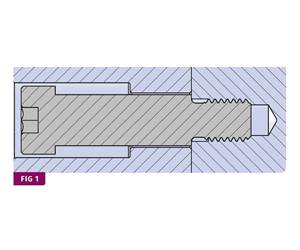The Final Check
The roar of fighter jets taking off one after another drowned out the frantic screams of the plane captain running towards me, but the look on his face made it obvious there was a problem.
The roar of fighter jets taking off one after another drowned out the frantic screams of the plane captain running towards me, but the look on his face made it obvious there was a problem. When he reached my launch position on the runway, he only had enough breath left to mutter, “nose-gear pin.” That was enough. We both spun around to see the last jet of the day, loaded up with bombs and fuel, lifting off the tarmac. The red flag attached to the nose-gear safety pin waved at us from the belly of the jet, visible to all but the pilot. He would not get far. Landing gear won’t retract with a safety pin installed.
Seconds later, the rookie fighter pilot radioed the commander that his wheels would not retract and that he would have to abort the bomb run and return to base. He was not at all amused to discover he would have to land with the bombs still attached to his wings, but was able to do so without blowing up the plane.
Immediately following that incident, a position was created called “final check” and posted at the beginning of the runway. We never launched another plane with a safety pin installed.
As a jet mechanic in the Navy, helping to launch those jets off the flight line drove home the unfavorable impact of missing even the simplest of tasks. While maybe not as life-threatening (depending upon your boss’s demeanor), a simple mistake in reassembling a plastics mold after maintenance can still be catastrophic. Memory lapses cost companies thousands of dollars monthly in unscheduled downtime, lost production, extra labor hours, and sometimes lost business.
As with any job that involves repetitive maintenance, it becomes easy after a while to lose focus. It is the simple fundamentals that often get overlooked in maintenance shops. Too many molds are set and started, only to be shut down, pulled, and returned to the shop to correct something simple that was forgotten or taken for granted during the final stages of assembly. With new molds becoming ever more complex, the consequences of inattention can be severe. And missed or late production quotas can be economically deadly in today’s customer- satisfaction oriented environment.
ANTICIPATE MISTAKES
So what can we do to address the pitfalls of human nature? Make signs. Big ones, And hang them on the walls of your shop for all to see. Signs that spell out exactly what is required before any mold is tagged “ready for production.” Every mold-repair shop should have a final checklist posted on the wall, entered into the company GOP (Good Operating Practice) standards, and enforced by the shop supervisor.
At a repair shop I visited recently, one couldn’t avoid noticing two large (4 x 8 ft) signs hanging prominently on the wall. One was mounted above a door the molds passed through on the way out of the shop, and the other was right next to the clock—which is always the most observed item in any shop.
The signs contained a list of final-check procedures that all repair technicians were responsible for. If a mold came back due to an oversight or lackadaisical attitude, the repair technician was open to disciplinary action and even worse—the humiliation of being unable to notice and heed the giant sign beside the clock.
Many shops use a formatted checklist specifying actions required and a space for the technician to sign (or initial) and date when the action was completed. The problem with this method is that the checklist is usually filled out as an afterthought, long after the mold is finished, closed up, and racked or sent back to production. It becomes just another piece of useless paperwork to most techs because they feel comfortable with remembering what they are supposed to check, and if something is forgotten now and then … “Oh well, we’ll get it tomorrow.”
Technicians are constantly under the gun to get molds repaired and returned as quickly as possible. Posted signs are much more helpful and effective than a sheet of paper to remind them to begin final-check proceedings before the mold is closed up and sent out of the shop. The vast majority of skilled tradespeople want to be good at what they do and respond more favorably to visual reminders than to another piece of paper to sign.
Shop signs can also remind the passing supervisor to demonstrate the importance of performing final checks by occasionally asking the tech where they are on the list—Step One? Two? Four?
Accompanying this article is a sample of a typical final checklist. It should be made of hard plastic, not the common foam board or poster board, which are easily damaged. A sign 36 x 48 in. long with nine or 10 lines of text usually has enough room for letters about 3 in. tall, which are easily legible from the bench in most shops. You can purchase a sign this size for around $150, and 4 x 8 ft signs can be made for around $300, depending upon the total number of words. If you track (and you should) the costs associated with molds returning for missed checks during assembly, the ROI on a sign could be just one incident prevented.
As a Navy jet mechanic, I learned the importance of working to a set of MIL standards to maintain repair/rebuild quality of our jets. The military realized long ago that signs and posters on the walls of hanger decks helped mechanics remember to perform specific procedures and checks so that we only had to do the job once, and our pilots could concentrate on the mission, not the plane.
ABOUT THE AUTHOR
Steven Johnson worked as a toolmaker for 26 years, rebuilding and repairing multicavity molds for Calmar Inc. and then as mold-maintenance engineer for Hospira Inc., a medical device manufacturer. Today, he is the maintenance systems manager for Progressive Components and has his own business, MoldTrax in Ashland, Ohio, which designs and sells software for managing mold maintenance (www.moldtrax.com). He can be reached at steve@moldtrax.com or (419) 289-0281.
Related Content
Back to Basics on Mold Venting (Part 1)
Here’s what you need to know to improve the quality of your parts and to protect your molds.
Read MoreThe Impact of Hydraulics on Tool Design -- Part 1 of 2
Get a better understanding of their use, proper sizing, and how the tool design and setup in the machine can impact failures in manufacturing.
Read MoreWhy Shoulder Bolts Are Too Important to Ignore (Part 2)
Follow these tips and tricks for a better design.
Read MoreWhere and How to Vent Injection Molds: Part 3
Questioning several “rules of thumb” about venting injection molds.
Read MoreRead Next
See Recyclers Close the Loop on Trade Show Production Scrap at NPE2024
A collaboration between show organizer PLASTICS, recycler CPR and size reduction experts WEIMA and Conair recovered and recycled all production scrap at NPE2024.
Read MoreFor PLASTICS' CEO Seaholm, NPE to Shine Light on Sustainability Successes
With advocacy, communication and sustainability as three main pillars, Seaholm leads a trade association to NPE that ‘is more active today than we have ever been.’
Read More



















